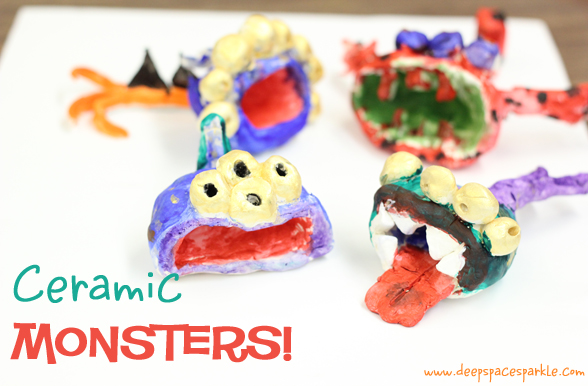
I’m a planner. I like to be prepared. So whatever happened during those last few weeks of school that left me staring at 200 pieces of unglazed bisque, I’ll never know. I’m blaming Star Testing and the mutual decision to abandon the art schedule during testing and just tack 2 weeks on the end of the school year. Seemed perfectly fine, except I forgot that I had to do a ceramic project with my 1st-4th graders.
The clay part of the pinch pot went swimmingly well considering there was only 10 days of school left. My first graders must have sensed my panic for they molded and shaped and scratch-attached their little pinch-pot monsters together in record time. After they dried and bisque fired, my calendar registered that yes, there was indeed 5 days left until the end of school.
Certainly enough time to paint with underglaze, glaze and do a second firing, right? Yes, but the 6th grade mural was moving along a bit slowly too. The mural project is the big Kahuna…the Grand Finale for the sixth graders. I couldn’t let them finish their elementary years with a half-done project, could I?
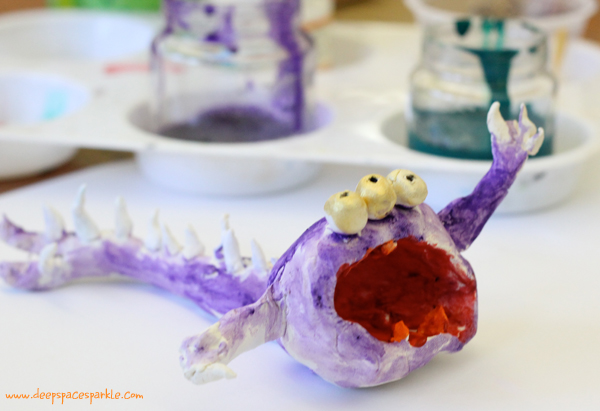
No, of course not. So after realizing that the pinch pot monsters and a few other ceramic projects would have to be sacrificed for the greater good of the school, I decided that acrylic paints were the only answer. I had a few bottles stored in a back shelf somewhere. And they’d work out fine. Who would know the difference?
Apparently, the kids would. After demonstrating the proper way to paint with acrylics, I told the kids that the best part about painting with acrylics was that they would be able to take the project home that day! And that never happens! I thought they’d be excited but a few of them looked at each other and said, “I thought you had to fire them again?”.
“Um, yup.”
Oh well. We pushed on and you know, the project turn out great. I got so excited at the thought of not having to glaze and do a second firing, I threw caution to the wind and pulled out my metallic tempera paints. The gold applied beautifully to the bisque! Who would have thought!
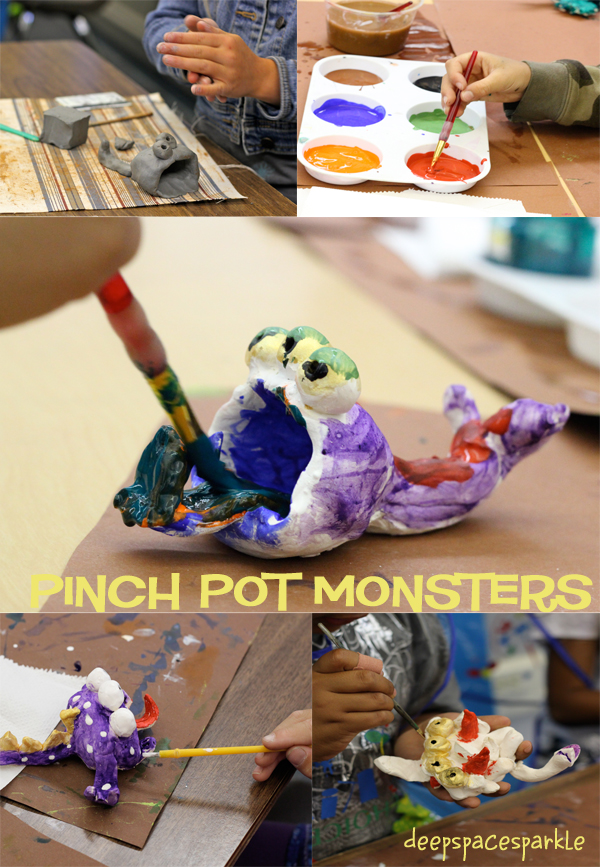
I still prefer underglaze and glaze and I will continue to try and organize my ceramic units to accommodate the time it takes to do the required second firing, but I’m breathing easier knowing I have a solid backup at the ready.
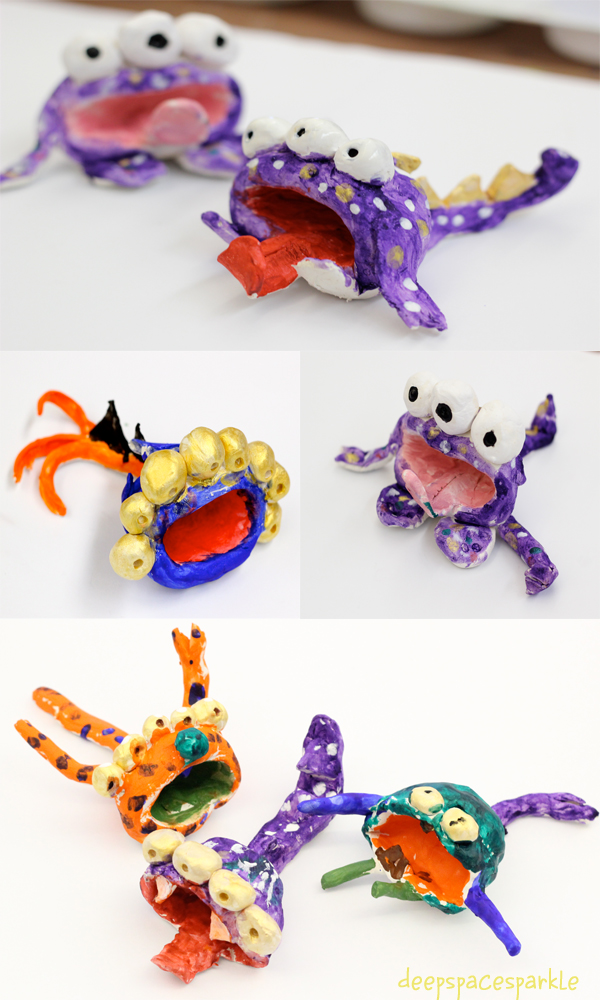
So tell me, do you use acrylics paints on bisque?
Love this lesson on monsters? Click the yellow button below to download a free lesson PDF on how to draw monsters!

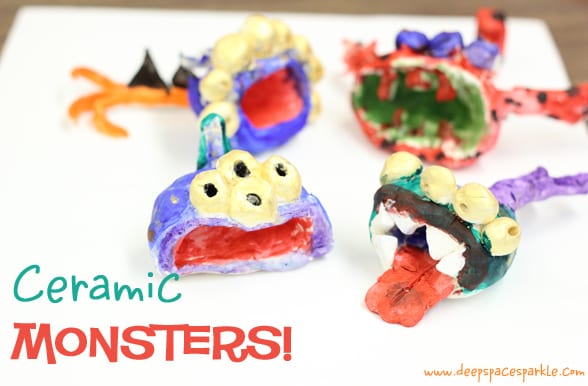












Those are adorable! I will have to borrow the monster idea for summer school! And yes in a time pinch I do use acrylics on bisque. I did it with our clay food- it worked great because my 4th and 5th graders were able to mix colors to make the food look realistic. I also have used sparkly watercolor on a K/1 project- they were glittery, colorful and so fun! I will definitely do that again!
For my summer school ceramics class I ran out of time to do two firings this week so we underglazed the greenware and then bisque fired. That worked great too! Very colorful results.
I use acrylics all the time with 450 students. I also use the acrylics watered down to give a celadon appearance / oxide look. I also use crayon and sumo e ink on clay for another great finish !!! If anyone would like the techniques just email me .
cooperberner@ gmail.com
I use both acrylics and even tempera on clay because I teach 800+ students in grades 1-8. Glaze is more expensive, so when it makes sense for the project, I’ve used paint instead. This year I was able to get some metallic paints and my seventh grade students loved using it on their Robert Indiana inspired word sculptures. Like Patty, we were at the end of the year, so there was no time to fire glaze. I’ll probably use the paints again this year because it was such a success this year.
I have to say that I love to use glaze but there are times when I do use paint. I use tempera more than acrylic. When I have students paint on bisque I make sure to add a touch of gloss modge podge to the paint and also when dry I have students add a thin layer of gloss modge podge again. I think it looks better with a nice shine!!!
I’m going to try that next year for sure. Thanks for the tip!
those are awesome. my girls would love that craft. thanks for sharing.
I will be teaching Lower School Art (grades 1 -6) in the fall. We do not have a kiln as a fire destroyed the Art Dept in 2011. Can this project be adapted to air dry clay? Does your clay project pdf only deal with clay that must be fired? Thank you.
Hi Jean,
The directions to build the piece would be the same whether you are using air dry or not…you just wouldn’t need to fire the pieces. Having said that, I have never used air dry clay before and I am a bit unsure of it’s properties.
My PDF project only demonstrates fired clay pieces.
We made these clay monsters at summer camp two weeks ago using AMACO grey air-dry clay. The kids loved them, but the air-dry clay is more fragile than kiln-fired clay. I had to glue a few horns, teeth, and eyeballs that broke.
Sax carries a great pearl tempera that I use with a coat of acrylic sealer or Mod Podge when the paint dries. It gives a more finished look and goes a long way. I think that I will try to use paint K-2 this year and glaze 3-5. There are some examples on my web site.
Popped in from SITS to say hi!
Your blog has some of the best art projects for kids out there. I usually get ideas for my daughter. She loves it!
Are the properties for modge podge and varnish about the same? Is one safer for younger grades then the other? There are gallon sized tempera varnish (and acrylic varnishes) out there on websites like SAX/School speciality. This upcoming year will be my first year teaching art at a public school, thus first time doing clay projects. I am new to the “finishing” aspect of clay projects. We will need to do air-dry clay as we don’t have a kiln. Love this project! Want do do tempera and have it shiny to finish.
I use watercolor on bisque for one of my clay projects. That gold tempera looks so good…I will definitely add that to the project. After all the bisque has been painted, I take it outside and spray the whole lot with Painter’s Touch clear gloss.
I decided to do these with my summer school group- I linked your original post here: http://artrageousness.blogspot.com/2012/07/summer-school-session-2-pinch-pot.html
Thanks for sharing! I am loving your site so much this summer as I’m doing my planning for next year! I’ve tagged many of your posts on my Evernote account so I can find the projects easily next year! 🙂
I’ll be using this idea for our next pottery project, thanks again for the inspiration! I teach after-school art classes at 5 different schools – I have to carry everything with me to each class, so no drying areas or projects that take more than one lesson of one and a half hours (can you imagine transporting 24 wet paintings?). The exception is pottery, which I fire in a friend’s kiln. Glazing would be just too hard, so I always paint with house paint – it stays on well and has good coverage. 🙂 Elizabeth
I have a clay butterfly project that I do with 1st grade. We use watercolors to paint it! The liquid watercolors turn out nice and bright and can create some beautiful effects on the bisqued clay. The clay soaks it up and drys almost on contact. I agree that glazing and a second firing is awesome and is my main method; however, having these short cuts really helps!
I was displaced after teaching High School & Adult ceramics… now I’m teaching K-6.
These monsters are awesome, and remind me of the monster I made in 3rd grade, (ahem) 44 years ago! For an end of semester project I have had HS students use water colors and then sprayed them with a gloss acrylic or laquere (My room had a spray booth). HOWEVER, I have painted or dipped Future Floor finish on burnished pit fired pieces… perhaps that is a cheap, non-toxic way to go over water color which is brilliant and shows all the textures!
I am new to teaching K-4 art and new to ceramics. Are the ceramic things as strong if they aren’t fired again? Can I glaze greenware on a regular basis instead of firing twice? Thanks! love your site! It is filled with so much great info. I have bought quite a few of your lesson plan ebooks. Thanks!
Unless you buy a glaze that can double as an underglaze and glaze, you’ll have to fire twice. But, many teachers, and even me on occasion, paint the bisque 9greenware fired once) with acrylic paints.
Hi Patty,
I just found your blog– and I LOVE it! I teach 2nd grade and am always looking for new ways to integrate art into my classroom. I enjoy that your lessons allow for students to many different tools to produce their products. I appreciate that your lessons can be integrated through different subjects, too! Your blog is well-organized and easy to maneuver– the fact that you have lessons separated by grade levels and subject matter is wonderful. I will definitely be sharing this great resource with colleagues and will be stopping back often to see the new ideas you have to share! Thank you.
I like to link/incorporate literacy with many of the projects I do with my students, as do you, too. 🙂 I read the book “I Need My Monster,” and the students LOVED the book AND doing the pinch pot monsters! Thanks for the creative lesson! 😉
I teach middle school and do a project like this with 7th grade. We don’t use glaze on them because I’ve found I get more detailed and colorful results with watercolor, metallic watercolor, Sharpie paint marker and metallic paint marker. They can use any combination of these supplies. They always look great!
I’ve been looking for answers online, but I can’t seem to find much. This is my first year of art teaching and would like to make some ceramic figurines for our school garden. I will be using earth clay and will be glazing them. Will this make them safe to leave outdoors?
You are probably safe. Just cHeck with the clay and glaze manufacturer to see if what you are using is weather proof for your geographical area.
Hi Angie, glazing should make them great for outdoors. I have also had some luck with Thompson’s water seal on garden stones and clay that isn’t glazed.
Hi. I will be teaching art part-time for the 1st time for grades K-8. I’ve never taught sculpture to my students, but the curriculum requires clay techniques (pinch and coil; additive and subtractive sculpture). I don’t have a kiln. What should I use? What type of clay? Air dry clay? Can that be painted once dry?
Thanks, Carmen
I like Laguna Air dry clay. works pretty much the same as kiln-clay. Yes, you can paint it. I don’t have a link to share but you can try googling it.
Those are wonderful! Have you read “Rotten Island” by William Stieg? Your adorable monsters reminded me of this great book: http://www.amazon.com/Rotten-Island-William-Steig/dp/0879235268
Haven’t heard of this book. Sounds great! Thanks.
Hi Patty! I use acrylic on bisque fired clay for 6th graders, but I almost exclusively use Chromatemp Pearlescent paint for K-1. It looks fabulous on white clay and covers beautifully. I buy it from Nasco.
As a title I art teacher I dont have the budget or time (or a big kiln) to underglaze, glaze and fire the clay. We use watercolors instead. the watercolors absorb into the clay and allows for some gorgeous blending, plus it dries in 3-5 minutes per layer. Once dry we use a paint glazing medium that they paint all over the clay and allow it to dry overnight.